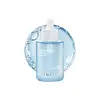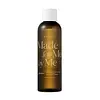What's inside
What's inside
 Key Ingredients
Key Ingredients

 Benefits
Benefits

 Concerns
Concerns

 Ingredients Side-by-side
Ingredients Side-by-side

Water
Skin ConditioningPropanediol
SolventPanthenol
Skin ConditioningGlycerin
HumectantGlycereth-26
HumectantNiacinamide
Smoothing1,2-Hexanediol
Skin ConditioningPolyglyceryl-10 Laurate
Skin ConditioningDiethoxyethyl Succinate
SolventHydroxyacetophenone
AntioxidantCarbomer
Emulsion StabilisingHydroxyethyl Acrylate/Sodium Acryloyldimethyl Taurate Copolymer
Emulsion StabilisingTromethamine
BufferingXanthan Gum
EmulsifyingAllantoin
Skin ConditioningAdenosine
Skin ConditioningDextrin
AbsorbentDisodium EDTA
Sorbitan Isostearate
EmulsifyingCaprylyl/Capryl Glucoside
CleansingButylene Glycol
HumectantGlutathione
Gardenia Florida Fruit Extract
Skin ConditioningSerenoa Serrulata Fruit Extract
Skin ConditioningArginine
MaskingCopper Tripeptide-1
Skin ConditioningBiotin
AntiseborrhoeicCysteine
AntioxidantGlutamic Acid
HumectantEthylhexylglycerin
Skin ConditioningSh-Decapeptide-7
AntioxidantSh-Octapeptide-4
AntioxidantSh-Oligopeptide-9
HumectantSh-Pentapeptide-19
Skin ConditioningZinc
AntioxidantParfum
MaskingWater, Propanediol, Panthenol, Glycerin, Glycereth-26, Niacinamide, 1,2-Hexanediol, Polyglyceryl-10 Laurate, Diethoxyethyl Succinate, Hydroxyacetophenone, Carbomer, Hydroxyethyl Acrylate/Sodium Acryloyldimethyl Taurate Copolymer, Tromethamine, Xanthan Gum, Allantoin, Adenosine, Dextrin, Disodium EDTA, Sorbitan Isostearate, Caprylyl/Capryl Glucoside, Butylene Glycol, Glutathione, Gardenia Florida Fruit Extract, Serenoa Serrulata Fruit Extract, Arginine, Copper Tripeptide-1, Biotin, Cysteine, Glutamic Acid, Ethylhexylglycerin, Sh-Decapeptide-7, Sh-Octapeptide-4, Sh-Oligopeptide-9, Sh-Pentapeptide-19, Zinc, Parfum
Water
Skin ConditioningButylene Glycol
HumectantGlycerin
Humectant1,2-Hexanediol
Skin ConditioningBifida Ferment Lysate
Skin ConditioningPentylene Glycol
Skin ConditioningPropanediol
SolventCentella Asiatica Extract
CleansingFicus Carica Fruit Extract
HumectantArtemisia Princeps Leaf Extract
Skin ConditioningUlmus Davidiana Root Extract
Skin ConditioningAmaranthus Caudatus Seed Extract
Skin ConditioningHydrogenated Lecithin
EmulsifyingJuniperus Virginiana Oil
MaskingCedrus Atlantica Bark Oil
MaskingAmyris Balsamifera Bark Oil
MaskingPogostemon Cablin Leaf Oil
MaskingSodium Hyaluronate
HumectantMethylpropanediol
SolventOctyldodeceth-16
EmulsifyingFructooligosaccharides
HumectantCarbomer
Emulsion StabilisingTromethamine
BufferingSodium Acrylic Acid/Ma Copolymer
Disodium EDTA
Copaifera Officinalis Resin
MaskingCeramide NP
Skin ConditioningLactobacillus Ferment Lysate
Skin ConditioningLactococcus Ferment Lysate
Skin ConditioningBifida Ferment Filtrate
Skin ConditioningSaccharomyces Ferment Filtrate
HumectantEthylhexylglycerin
Skin ConditioningCaprylyl Glycol
EmollientWater, Butylene Glycol, Glycerin, 1,2-Hexanediol, Bifida Ferment Lysate, Pentylene Glycol, Propanediol, Centella Asiatica Extract, Ficus Carica Fruit Extract, Artemisia Princeps Leaf Extract, Ulmus Davidiana Root Extract, Amaranthus Caudatus Seed Extract, Hydrogenated Lecithin, Juniperus Virginiana Oil, Cedrus Atlantica Bark Oil, Amyris Balsamifera Bark Oil, Pogostemon Cablin Leaf Oil, Sodium Hyaluronate, Methylpropanediol, Octyldodeceth-16, Fructooligosaccharides, Carbomer, Tromethamine, Sodium Acrylic Acid/Ma Copolymer, Disodium EDTA, Copaifera Officinalis Resin, Ceramide NP, Lactobacillus Ferment Lysate, Lactococcus Ferment Lysate, Bifida Ferment Filtrate, Saccharomyces Ferment Filtrate, Ethylhexylglycerin, Caprylyl Glycol
 Reviews
Reviews

Ingredients Explained
These ingredients are found in both products.
Ingredients higher up in an ingredient list are typically present in a larger amount.
1,2-Hexanediol is a synthetic liquid and another multi-functional powerhouse.
It is a:
- Humectant, drawing moisture into the skin
- Emollient, helping to soften skin
- Solvent, dispersing and stabilizing formulas
- Preservative booster, enhancing the antimicrobial activity of other preservatives
Butylene Glycol (or BG) is used within cosmetic products for a few different reasons:
Overall, Butylene Glycol is a safe and well-rounded ingredient that works well with other ingredients.
Though this ingredient works well with most skin types, some people with sensitive skin may experience a reaction such as allergic rashes, closed comedones, or itchiness.
Learn more about Butylene GlycolCarbomer is a polymer of acrylic acid. Its main role is to create a gel consistency.
A high amount of carbomer can cause pilling or balling up of products. Don't worry, most products contain 1% or less of carbomer.
Disodium EDTA plays a role in making products more stable by aiding other preservatives.
It is a chelating agent, meaning it neutralizes metal ions that may be found in a product.
Disodium EDTA is a salt of edetic acid and is found to be safe in cosmetic ingredients.
Learn more about Disodium EDTAEthylhexylglycerin (we can't pronounce this either) is commonly used as a preservative and skin softener. It is derived from glyceryl.
You might see Ethylhexylglycerin often paired with other preservatives such as phenoxyethanol. Ethylhexylglycerin has been found to increase the effectiveness of these other preservatives.
Glycerin is already naturally found in your skin. It helps moisturize and protect your skin.
A study from 2016 found glycerin to be more effective as a humectant than AHAs and hyaluronic acid.
As a humectant, it helps the skin stay hydrated by pulling moisture to your skin. The low molecular weight of glycerin allows it to pull moisture into the deeper layers of your skin.
Hydrated skin improves your skin barrier; Your skin barrier helps protect against irritants and bacteria.
Glycerin has also been found to have antimicrobial and antiviral properties. Due to these properties, glycerin is often used in wound and burn treatments.
In cosmetics, glycerin is usually derived from plants such as soybean or palm. However, it can also be sourced from animals, such as tallow or animal fat.
This ingredient is organic, colorless, odorless, and non-toxic.
Glycerin is the name for this ingredient in American English. British English uses Glycerol/Glycerine.
Learn more about GlycerinPropanediol is an all-star ingredient. It softens, hydrates, and smooths the skin.
It’s often used to:
Propanediol is not likely to cause sensitivity and considered safe to use. It is derived from corn or petroleum with a clear color and no scent.
Learn more about PropanediolTromethamine helps balance the pH and improve the texture of a product. It is synthetically created.
As an emulsifier, Tromethamine prevents oil and water ingredients from separating. This helps stabilize the product and elongate a product's shelf life. Tromethamine also makes a product thicker.
Tromethamine helps balance the pH level of a product. Normal pH level of skin is slightly acidic (~4.75-5.5). The acidity of our skin is maintained by our glands and skin biome. Being slightly acidic allows our skin to create an "acid mantle". This acid mantle is a thin barrier that protects our skin from bacteria and contaminants.
Oral Tromethanmine is an anti-inflammatory drug but plays the role of masking, adding fragrance, and/or balancing pH in skincare.
1,3-Propanediol, 2-amino-2-(hydroxymethyl)-
Learn more about TromethamineWater. It's the most common cosmetic ingredient of all. You'll usually see it at the top of ingredient lists, meaning that it makes up the largest part of the product.
So why is it so popular? Water most often acts as a solvent - this means that it helps dissolve other ingredients into the formulation.
You'll also recognize water as that liquid we all need to stay alive. If you see this, drink a glass of water. Stay hydrated!
Learn more about Water